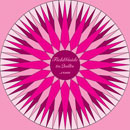Mariner's Compass
 Mariner's Compass Mountain Mist Mariner's Compass Mountain Mist
 This 32-point block has split points with two colors each — a challenging block designed for expert quilters. This 32-point block has split points with two colors each — a challenging block designed for expert quilters.
Mountain Mist, which was and is a batting company, reportedly published this pattern, but we don't know when. Click on the "Make It!" icon at upper right for a diagram.
At right, a real-life antique quilt sold on eBay a few years ago by eBay seller French72.
Batting, by the way, is the sheet of puffy stuff that goes between the front and back of a quilt.
|

Mariner's Compass (Mountain Mist)
Photo: eBay seller French 72. Used with permission. |
|
Single Sunflower
 Single Sunflower Single Sunflower
This relatively simple 16-point star is from the Ladies Art Company's 1897 catalog (#367). We've posted a diagram; click on the icon at right. |
|
Russian Sunflower
 Russian Sunflower Russian Sunflower
 Russian Sunflower, from 1932, was designed by the Kansas City Star's Evelyn Foland. Foland put in seams outside the circumference of the star. Russian Sunflower, from 1932, was designed by the Kansas City Star's Evelyn Foland. Foland put in seams outside the circumference of the star.
Those four seams are not there to help quilters make the block: The points are solid pieces that match up at the point with the quarter seams. Seam would have to meet seam to simplify construction. Rather, the design seems to be a way to add space between the circles. Compare the mockup to that of Single Sunflower, above, and see what you think.
The Star republished the block twice, as Oklahoma Sunburst and Brave Sunflower, in 1933 and 1951. |
|
Chips & Whetstones
 Chips & Whetstones Chips & Whetstones
 Chips & Whetstones Chips & Whetstones
 wrote in 1929 that this block name "rings with the masculine sound of a good sharp ax, necessary for the splitting of rails and firewood." wrote in 1929 that this block name "rings with the masculine sound of a good sharp ax, necessary for the splitting of rails and firewood."
We add to that Emerson's statement that "Every man looks at his wood-pile with a kind of affection." A quilter would regard her block the same way.
There are several Chips & Whetstones variations. This one is from Jinny Beyer's Quilter's Album of Patchwork Patterns, which cites the book Quilts of Virginia. The block dates back to about 1840. We've added an applique version of the block below.
|
|
Chips & Whetstones
 Chips & Whetstones Chips & Whetstones
 the block that is pieced. Our source is Finley's 1929 Old Patchwork Quilts. The quilt in the book is not dated. the block that is pieced. Our source is Finley's 1929 Old Patchwork Quilts. The quilt in the book is not dated.
Quilt researcher Carrie Hall stitched up a similar block for a collection that is now part of the Spencer Museum at the University of Kansas. The difference is that Hall's version has six points per quarter block.
|
|
Rising Sun
 Rising Sun Rising Sun
 Compass Compass
Ruth Finley, in Old Patchwork Quilts (1929), included a photograph of a quilt with no fewer than nine of these 64-point showstoppers, each 30 inches across. Spaced between the compasses, which were pieced in orange and white, were appliquéd garlands. The quilt was made about 1800 on Long Island, NY.
|
Barbara Brackman, in Encyclopedia of Pieced Quilt Patterns, cites a 1957 catalog of the Shelburne Museum of Shelburne, Vermont for the name Mariner's Compass.
We've seen several Rising Suns at the International Quilt Festival in Houston. Talk about overachievers! But then, what else can you do for a challenge when you keep improving your skills? That's one of the things that keeps quilters coming back.
We've seen quilts that were made from fabric hand-dyed by the quilter before going into an exquisite original design. We've seen at least one Baltimore Album quilt made only of the same supplies used by quilters of the mid-19th century.
It's quilt pox. Highly contagious. You've been warned. |
|
Slashed Star
 Slashed Star Slashed Star
Rising Sun/Sunburst/Twinkling Star/Mariner's Compass
 Slashed Star Slashed Star
 The Ladies Art Company's Slashed Star (#266, 1897) was the first published mariner's compass block we've seen. The block was named Mariner's Compass only in 1980, in Quilters Newsletter Magazine, according to Brackman's Encyclopedia. The Ladies Art Company's Slashed Star (#266, 1897) was the first published mariner's compass block we've seen. The block was named Mariner's Compass only in 1980, in Quilters Newsletter Magazine, according to Brackman's Encyclopedia.
In 1937, designer Nancy Cabot presented the same star in the Chicago Tribune under the three other names listed above, along with the mind-boggling remark that the block is easy to piece.
We'd love to hear from anyone who agrees that stitching this 64-point block is a breeze. We feel sure that person is Superman's more talented sister.
Below, a four-color version of the same block. |
 Slashed Star in four colors Slashed Star in four colors  
 
Slashed Star in four colors |
|
 |
|
 Mariner's Compass
***
Mariner's Compass
***








 This 32-point block has split points with two colors each — a challenging block designed for expert quilters.
This 32-point block has split points with two colors each — a challenging block designed for expert quilters. 
 Single Sunflower
Single Sunflower Russian Sunflower
Russian Sunflower
 Chips & Whetstones
Chips & Whetstones
 Rising Sun
Rising Sun Slashed Star
Slashed Star Slashed Star
Slashed Star Slashed Star in four colors
Slashed Star in four colors